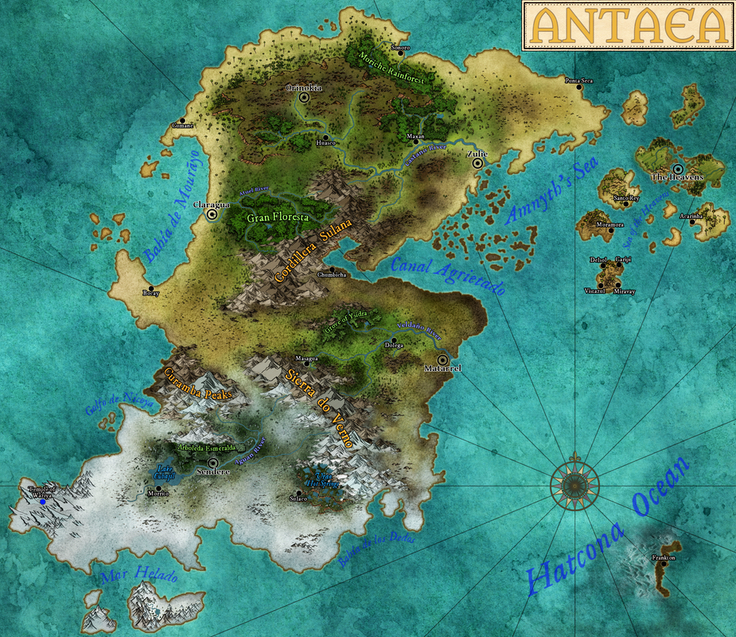Welcome to Antaea

Chronicles of Antaea
The Fragmented Land
Antaea, a vast expanse of diverse terrains and cultures, stands as a unique mosaic in the annals of history. Unlike other continents, Antaea's strength lies not in its unity but in its distinct regional identities. Each pocket of civilization fiercely guards its autonomy, making the continent a tapestry of vibrant, independent kingdoms.
The Arrival of Irna
In the year 1244ME, explorers from Irna ventured into Antaea, encountering a land teeming with formidable humanoid creatures. Amidst these challenges, resilient settlements of noble races had carved out their existence, always vigilant against potential threats. The arrival of the Irnans marked a turning point for these settlements. Eager for trade and alliances, they expanded into regional capitals, eventually demarcating the borders of their territories. With the might of Irna's armies and the unparalleled prowess of the fire swingers from Funta, the hostile humanoids were subdued, forever altering the balance of power in Antaea.
The Heavens: The Unconventional Power Center
While Antaea lacks a centralized governing body, The Heavens, a majestic floating island, has emerged as the de facto center of influence. Positioned just off the coast of Antaea, this island has swiftly risen to prominence. The regional kingdoms of Antaea view this arrangement favorably, preferring the distant oversight of The Heavens to the direct intervention of Irnan nobility.
The Duality of Antaea
The northern territories of Antaea are distinguished by their rich and diverse traditions, drawing inspiration from ancient civilizations. These areas are celebrated for their exceptional artisanship and pioneering spirit, crafting a myriad of distinctive goods that are coveted throughout the known lands.
In stark contrast, the southern territories of Antaea are a realm of mysteries and challenges. Dominated by towering giants, enigmatic Ice Elves, the elusive White Dwarves, and practitioners of the dark arts, this region remains largely uncharted and is often viewed with caution by the rest of Dort.
Laws of Antaea
Unlike other lands, Antaea grew up with a serious case of individuality. The Laws on Antaea reflect the independent nature of the land. The only exception is The Heavens where there is a lot more governance and more constitutional in nature.
Nobility and Titles
In Antaea common, these are the titles for the nobility:
- Sapa (Supreme ruler or emperor) - Equivalent to an Emperor or King.
- Ñusta (Princess or queen) - A title for a female royal, either a queen or princess.
- Apu (Noble lord) - A regional ruler or noble lord, overseeing a specific territory or province.
- Kuraka (Local chieftain) - A local leader or chieftain, often in charge of a village or small settlement.
Food and Culture
Foods
Antaea, a land where the mountains kiss the sky and the island's waves whisper tales of old, boasts a culinary tapestry as vibrant as its landscapes. At the heart of Antaean meals is maize, transformed into soft tortillas or steamed tamales, telling stories of ancient traditions. The pastures yield meats that are seasoned, grilled, and celebrated in feasts. The land's fertility is evident in its chilies, tomatoes, and avocados, each adding layers of flavor to the dishes. And then there are the fruits, tropical delights that dance on the palate, reminding one of sun-kissed days and starry nights. Amidst this symphony of flavors, the dairy products, especially the queso fresco and crema, offer a creamy contrast, making each meal in Antaea a journey of discovery.
Antaea Food Commodities
Grains & Cereals
- Maize (Corn): The cornerstone of Antaean cuisine, used in tortillas, tamales, and arepas.
- Quinoa: A high-protein grain, often used in salads and side dishes.
- Amaranth: An ancient grain, popped and mixed with honey or molasses to make traditional sweets.
- Cassava: A starchy root, processed into tapioca or used in breads and stews.
Meats
- Beef: Often grilled as steaks or slow-cooked in rich stews.
- Pork: Used in a variety of dishes, from carnitas to empanadas.
- Chicken: Marinated and grilled, or used in soups like pozole.
- Fish: Especially from the Zulie coast, grilled or used in ceviches.
Legumes
- Black beans: A staple in many dishes, from soups to refried beans.
- Pinto beans: Often stewed or mashed and served as a side.
- Lentils: Used in hearty soups, especially in the Andean regions.
Vegetables
- Chilies: Ranging from mild to fiery, they add flavor and heat to many dishes.
- Tomatoes: A base for salsas, stews, and other dishes.
- Avocado: Sliced, mashed, or turned into guacamole.
- Yuca: A root vegetable, fried or boiled as a side dish.
Fruits
- Pineapple: Eaten fresh, grilled, or used in salsas and desserts.
- Mango: A tropical delight, consumed fresh or in smoothies.
- Guava: Often turned into pastes, jellies, or refreshing drinks.
- Passion fruit: A fragrant fruit, used in beverages, desserts, or eaten fresh.
Dairy
- Queso fresco: A soft cheese, crumbled over dishes or eaten on its own.
- Crema: A creamy dairy product, drizzled over dishes for richness.
In Conclusion
Antaea, with its contrasting landscapes and cultures, offers a glimpse into the complexities of coexistence and the resilience of its inhabitants. From the determined settlements that grew into regional capitals to the awe-inspiring presence of The Heavens, Antaea's story is a testament to the indomitable spirit of its people and their unwavering desire for autonomy and identity.